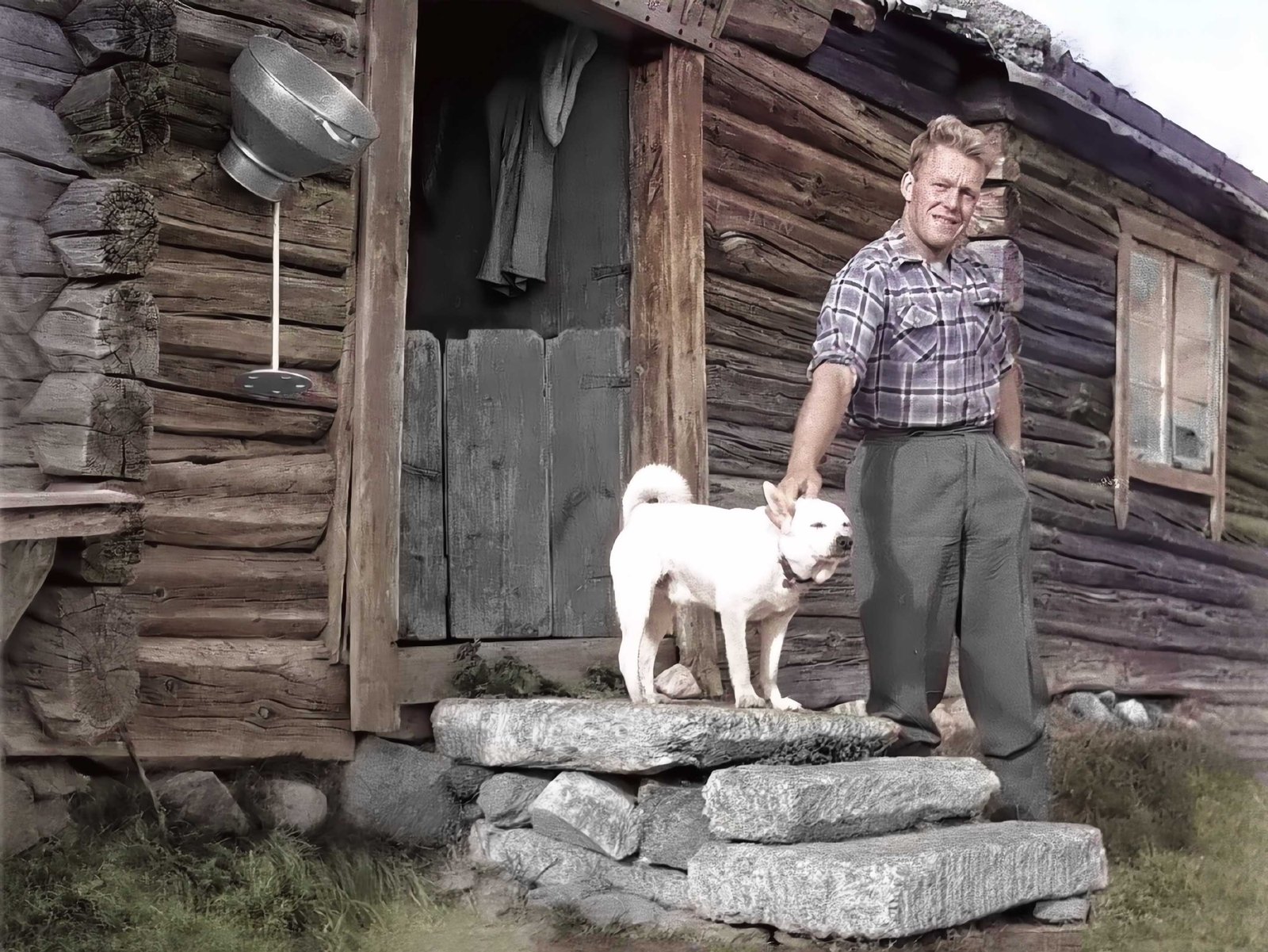A Buhund is not necessarily equal to a buhund
When we talk about a Norwegian buhund, we must distinguish between:
- The spitz dog and its place in ancient Norwegian history
- The Norwegian word buhund – a traditional farm dog
- The modern-day dog breed Norwegian Buhund – a spitz herding dog
The Norwegian word buhund is composed of two words: bu + hund = buhund. Bu means house, shed, farm, settlement – and can also mean livestock, as in the animals kept on a farm. The word hund means dog. The general meaning of the word buhund in English could be said to be farm dog, house dog, or livestock dog.
Let us take a closer and general look at Norwegian canine history – and how the breed Norwegian Buhund fits into this millennia-long story.
Norway’s early history
The first humans appeared in the Norwegian landscape after the last ice-age, some 12,000 years ago. They were nomadic or semi-nomadic hunters, fishers, and gatherers.
Archaeological finds show that the dog was an early addition to the Norwegian human family. Dog remains found in Norway’s northernmost region, Finnmark, are 5,000 years or older.
The early Norwegian dog was a spitz dog – just like the modern-day Norwegian Buhund breed. The spitz dog is characterised by erect, pointed ears – a pointed muzzle – and it often has a curled tail.
Throughout history – from the very beginning to our own time – the Norwegian dogs were crossbred with dogs coming from elsewhere in Scandinavia – and beyond.
Today’s Norwegian Buhund breed may not be genetically and directly linked to the very early Scandinavian dogs, but it is related – and most importantly: it is a bearer of the same ancient role and traditions.
A warning dog and a co-hunter
The early humans lived a vulnerable existence. Ill-intentioned neighbours and dangerous animals posed a constant threat. A dog, with its superior hearing and its bark, would signal danger – and if necessary – attack and protect.
For millennia, the Norwegian hunter-gatherers followed the prey on their seasonal journey through the landscape. The dog became a partner and a co-hunter, and joined its masters in the hunt for reindeer, moose, roe deer, fox, wood grouse, the smaller mountain grouse, and much more.
Living with and guarding the livestock
In the Later Stone Age, some Norwegians took up farming and settled more permanently on homesteads or in cottages scattered across Norway’s wild and contrasting landscape.
In this historical period, the dog also took on the role of protector of the farm animals. Often, the buhund lived among the livestock in the barn or shed – or in a doghouse in the farmyard.
In addition to guarding the people and the farm animals during the night, the buhund also accompanied and guarded the farm animals during the day, when they were feeding in the landscape surrounding the home farm.
Guarding the farm animals was a chore that the buhund often shared with the children of the family.
It was in this transforming period of Norwegian history that we see the role of the traditional buhund take shape. The historical buhund did not have an absolute colour or look – but it had a unique and vital role.
A more active herding dog
As the flocks of farm animals increased in size – and needed larger sections of pastureland where it could feed – the buhund also took on a more active herder role, driving sheep, goats, cattle, horses, pigs, and the half-domesticated reindeer from one area to the next.
The Norwegian landscape comprises only 3.5% cultivated land, and 40% forests and 40% mountainous land. In historical farming, the forests and the mountains were ideal pastureland during the summer months – and had to be utilised to the fullest.
For millennia, it was common to send the livestock away from the home farm during the summer months, to a simple, seasonal summer pasture farm in the forests or mountains. The animals were usually accompanied only by a milkmaid, a herder girl or boy – and a dog to assist them. The milkmaid milked the cows and the goats every 12 hours, and made cheese and butter during the day, when the herder and the dog took the animals out to roam and feed in the surrounding landscape.
The traditional buhund played an important role in helping to locate the farm animals in the landscape – gathering them into herds – driving the animals to and from their night shelter – and to and from the home farm at the beginning and end of the season.

Remains found in Viking graves
In the Viking Museum in Oslo, we find the Oseberg, Gokstad, and Tune Viking ships. They were found in grave mounds on the western and eastern side of the Oslofjord – dating back to around AD 800-900.
Both the Oseberg and Gokstad graves contained remains of spitz-type dogs.
The buhund is also mentioned in Snorri Sturluson’s Viking sagas.
The Norwegian Buhund as a breed
After Norway gained full independence in 1905, the country experienced a surge in energy and development. Despite a budding industrialisation, Norway was still very much a nation based on farming, fishing, and hunting.
In all areas of Norwegian society, enthusiasts pushed forward in educating the country and building a strong new nation.
One such enthusiast was Jon Sæland (1876-1963). He is by many said to be the one who saved the traditional buhund, by establishing it as a defined breed, giving it a more defined role – catapulting it into the new century.
At the time, the buhund as a type was in danger of disappearing, being crossbred and replaced by more recent dog breeds and breeds from abroad. People also often used the word buhund in a derogatory way, when describing farm dogs of dubious origin.
Sæland himself also used coarse language when describing many of the individuals that people referred to as a buhund. In his eyes, they were nothing but mongrels, not worthy of the title.
Sæland was a government advisor and specialist on sheep and goat farming. He was also a specialist on the utilisation of mountain and moorland pasture – and was determined to develop a most excellent Norwegian sheepdog.
In line with the times, he made what he believed to be the direct descendant of the ancient Norwegian dogs his first choice – with its local connection, history, and well-suited abilities.
He began the search for the individuals that he felt best represented the true buhund – and organised the first Norwegian Buhund dog show in 1925. The following year, he helped push through the first breed standard.
In the years that followed, Norwegian Buhund dog shows were held jointly with the state-organised sheep and goat shows – at least in those instances where Sæland was in charge. This cemented the connection between the Norwegian Buhund and its role as a herding dog.
A Norwegian sheepdog
Sæland mentions the name sheepdog in his early writings, and the breed could easily have ended up being called Norwegian Sheepdog.
Sæland’s own background from the rural part of the Norwegian region of Rogaland – and his general interest in the Norwegian language and Norway’s history – probably coloured the choice of breed name.
Flink was the top dog
The dog individual registered as number 1 in the Norwegian Buhund registry – and the dog that Sæland deemed to be the finest specimen of his time – was Flink from the farm Ravndal in Gjesdal, Rogaland, Norway.
Flink was said to have had a small portion of Scottish sheepdog in him, but Sæland didn’t see this as a problem – rather the opposite.
Flink still represented more than enough of the best of the characteristics and qualities handed down through the old stock – and was the model of the 1926 breed standard. Sæland confirms this in the pedigree register of 1938.
Flink was born in 1924, and when he took part in his last dog show in 1937, he still got 1st price.
In today’s Norwegian, the word flink means skilled and good. Historically it also had the meaning of fast and agile.

Not everyone agreed
It should be mentioned that not everyone agreed that Flink best represented the buhund ideal.
There were two main buhund fractions, both with roots in the south-western and sheep-rich region of Rogaland.
As time went on, the Sæland branch won the argument.
The colour of the coat
When today’s Norwegians think of the Norwegian Buhund, most think of a dog with a wheaten coloured coat.
However, the breed standard also includes reddish-wheaten, wheaten with dark-tipped hairs, and black – also allowing black with patches of white.
In early writings, both Sæland and others noted that the historical buhund was black more often than not.
The Norwegian Buhund club
The Norwegian Buhund club – Norsk Buhundklubb – was established in 1939, with 42 registered members.
135 Norwegian Buhunds attended the national all-dog-breeds-show of 1945, and they were the largest contingent of that year’s show.
Despite some rocky patches over the years, the club had around 400 members in 2017.
Currently, the annual number of Norway-registered Norwegian Buhund puppies lies between 100-150 per year – and the total Norwegian Buhund-population in Norway is about 1,000 plus.
Interest abroad
There has been an increased interest in the breed also outside Norway, and today there are Norwegian Buhunds in many countries across the world.
Both the UK and the US have their own Norwegian Buhund clubs.
A Mr Fanebust from Sauda in Rogaland sent two black buhunds – Bamse and Lefle – with the Norwegian America Line in 1931. They are said to be the first Norwegian Buhunds on American soil. Their new owner, Mr C.W. Voltz, greeted the two as they arrived in New York.
In 1958, a Mr Laidlow of Melbourne, Australia, imported two Norwegian Buhunds from the UK.
Major changes in agriculture and change of role
In more recent years, the number of Norwegian Buhunds and the interest for the breed has been somewhat erratic.
This is strongly connected to the significant change in Norwegian animal husbandry seen after World War II. A more industrialised agriculture rapidly replaced the old ways. This significantly affected the role of the traditional buhund.
However, enthusiasts are pushing forward and working hard to secure the breed for the future.
The Norwegian gene bank includes genetic material as part of this process. The scientists have given the Norwegian Buhund the status of critical.
Key roles today
The Norwegian Buhund is still used on some sheep farms and for hunting. But like with so many other dog types, it has also become a modern-day family dog. The breed has been used as a drug detection assistant, a hearing assistant, and more.

Who will be the next Sæland?
On many Norwegian farms, we often find an empty doghouse in the yard – abandoned and silent monuments of a time that was different.
But the pendulum of time may yet swing back. Maybe we will see the Norwegian Buhund return in larger numbers – and its role as the multi-talented farm dog reinstated – among the Norwegians – and beyond.
And who knows – maybe you are the one who will pick up the mantle – and be the new Sæland – in the next chapter of the history of the unique being that is the Norwegian buhund.
The 7 Norwegian dog breeds
- Norwegian Buhund
- Norwegian Elkhound Grey
- Norwegian Elkhound Black
- Norwegian Lundehund
- Norwegian Hound – or Dunker
- Halden Hound
- Norwegian Hygen Hound
Sources: Folkvord, Torbjørg et al. Norsk buhundklubbs jubileumsbok om buhund – historikk 1939-1999. Norsk Buhundklubb buhund.no | norwegianbuhund.org.uk | Norsk Kennel Klubb nkk.no | nibio.no | EGP.00113










